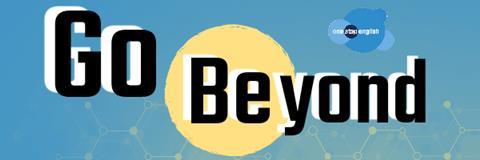Karen Kovacs introduces a series of American English lessons for teenagers at levels A1 to B2. This article provides information on the topics in the series and guidance on how to use the lessons.
The Go Beyond lessons on onestopenglish

With their creative and dynamic approach to topics, the Go Beyond lessons on onestopenglish motivate students to engage with the material, making language learning more meaningful and successful. The lessons are content-driven with a strong focus on skills, especially speaking. The tasks practice specific subskills, such as describing and explaining. The worksheets include Phrasebooks – reference boxes full of helpful language phrases relevant to a particular subskill that students can practice during the lesson.
The lessons focus on the topic and skills development, not on providing practice tasks for a specific language or grammar point. The levels assigned to the worksheets are determined by the language used in the texts and tasks on the worksheets. The worksheets focus on productive skills activities, meaning that the students determine the level of the language they produce in the classroom.
Every month, we will publish a new downloadable lesson. Each lesson consists of step-by-step teacher’s notes and photocopiable worksheets for students.
The series includes two collections of lessons:
Arts and Media
A collection of lessons related to art, television, literature, theater, advertising, and the press. Students practice their English while being creative.
In Arts and Media, students talk about art and draw on a wall in graffiti. They learn about BookCrossing, write about their favorite books, and become ghostwriters. They write news stories and create the front page of a newspaper. They complete a questionnaire about their TV viewing habits before starting their own television soap opera. They plan an advertising campaign and explore the world of William Shakespeare.
Knowledge
A collection of lessons related to school subjects such as geography, history, science, math, and technology. Students practice their English while learning about the world around them.
In Knowledge, students create a dream classroom, play a geography game, and fill their heads with numbers. They learn about the human brain, read about Albert Einstein, and travel to Mars. They discover if they are a technophobe or technophile and how Hollywood sometimes changes history. They complete a questionnaire about their own language-learning experiences.
Using the lessons
The lessons have been designed to provide teachers using the Macmillan secondary course Go Beyond with flexible supplementary materials for skills practice in the classroom. However, the lessons are versatile and can be used in various teaching contexts. They can be used both in the English language or CLIL classroom within a secondary school setting and in language schools. The lessons have been created for teenagers, but much of the material is also appropriate for teaching adults.
The content itself is also flexible. The lessons can be taught in isolation – each provides up to two hours of material – or you can extract individual tasks to supplement content from other sources. Each lesson includes advice on breaking down the content into sets of 90, 60, and 45 minutes of classroom time. This flexible approach means that you can use as much or as little of the content in this series as suits you and your students’ needs, and you can integrate the lessons with any coursebook.
Each self-contained lesson includes extensive teacher’s notes. These include:
- guidelines on timings
- a detailed summary and an overview of the key skills practiced
- step-by-step procedure
- full answer keys
- a homework task
Each lesson plan contains worksheets for students. These include:
- the complete set of tasks needed for the lesson
- language boxes that highlight chunks of language for students to practice in the lesson




No comments yet